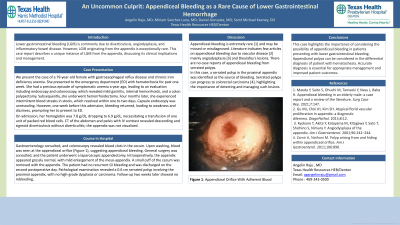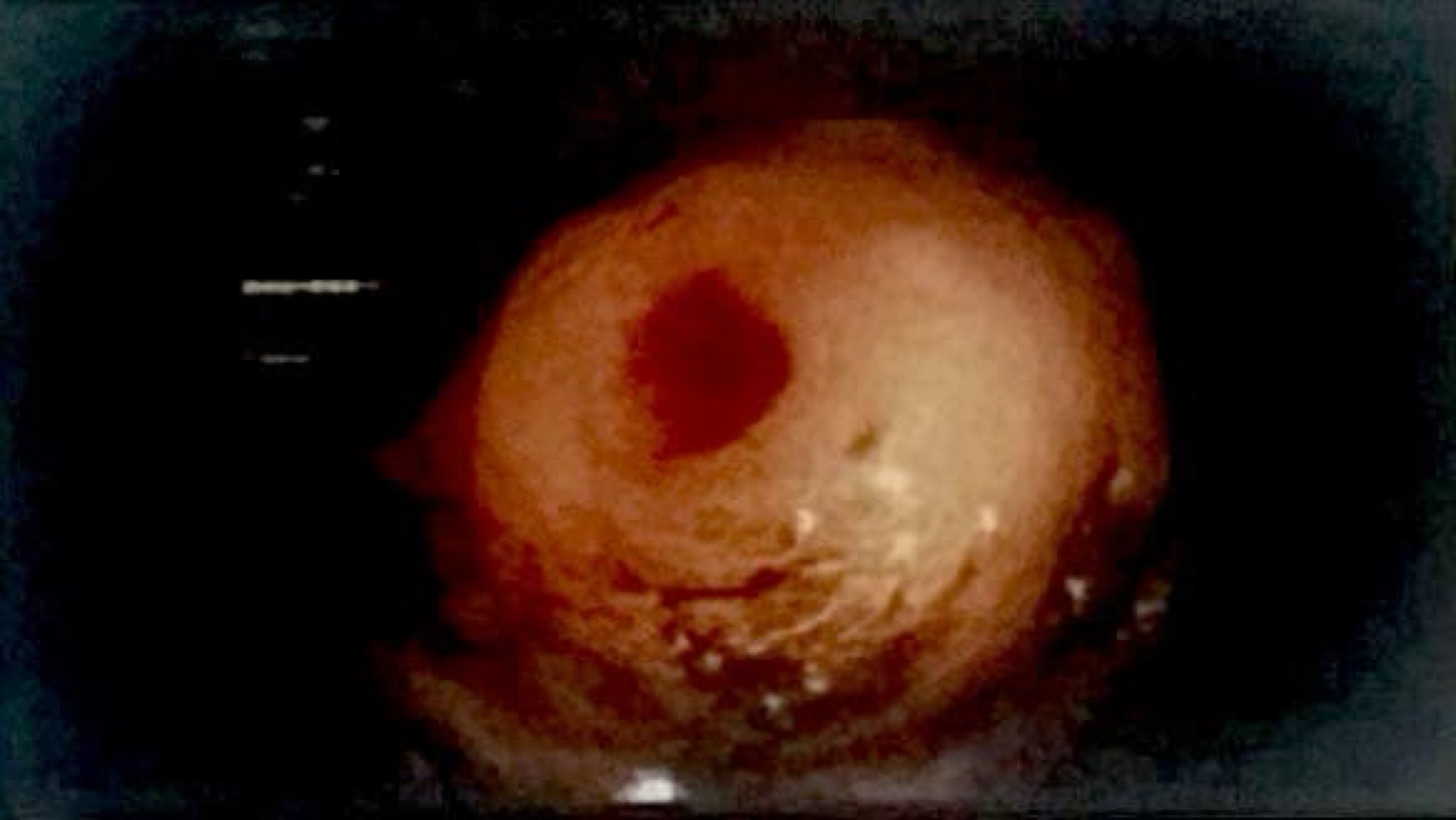Sunday Poster Session
Category: GI Bleeding
P0789 - An Uncommon Culprit: Appendiceal Bleeding as a Rare Cause of Lower Gastrointestinal Hemorrhage
Sunday, October 27, 2024
3:30 PM - 7:00 PM ET
Location: Exhibit Hall E

Has Audio

Angelin Raju, MD
Texas Health Resources HEB/Denton
Lewisville, TX
Presenting Author(s)
Angelin Raju, MD1, Miriam Sanchez Luna, MD2, Daniel Gonzalez, MD3, Keeney Scott, DO2
1Texas Health Resources HEB/Denton, Lewisville, TX; 2Texas Health Resources HEB/ Denton, Bedford, TX; 3Texas Health Resources, Lewisville, TX
Introduction: Lower gastrointestinal bleeding (LGIB) is commonly due to diverticulosis, angiodysplasia, and inflammatory bowel disease. However, LGIB originating from the appendix is exceptionally rare. This case report describes a unique instance of LGIB from the appendix, discussing its clinical implications and management.
Case Description/Methods: We present the case of a 79-year-old female with gastroesophageal reflux disease and chronic iron deficiency anemia. She presented to the emergency department (ED) with hematochezia for past one week. She had a previous episode of symptomatic anemia a year ago, leading to an evaluation including endoscopy and colonoscopy, which revealed mild gastritis, internal hemorrhoids, and a colon polypectomy. Subsequently, she underwent hemorrhoidectomy. Four months later, she experienced intermittent blood streaks in stools, which resolved within one to two days. Capsule endoscopy was unrevealing. However, one week before this admission, bleeding returned, leading to weakness and dizziness, prompting her to present to ED.
On admission, her hemoglobin was 7.8 g/dL, dropping to 6.9 g/dL, necessitating a transfusion of one unit of packed red blood cells. CT of the abdomen and pelvis with IV contrast revealed descending and sigmoid diverticulosis without diverticulitis; the appendix was not visualized. Gastroenterology consulted, and colonoscopy revealed blood clots in the cecum. Upon washing, blood was seen at the appendiceal orifice, suggesting appendiceal bleeding. General surgery was consulted, and the patient underwent a laparoscopic appendectomy. Intraoperatively, the appendix appeared grossly normal, with mild enlargement of the meso-appendix. A small cuff of the cecum was removed with the appendix. The patient had no recurrent GI bleeding and was discharged on the second postoperative day. Pathological examination revealed a 0.6 cm serrated polyp involving the proximal appendix, with no high-grade dysplasia or carcinoma. Follow-up two weeks later showed no rebleeding.
Discussion: Appendiceal bleeding is extremely rare and may be missed or misdiagnosed. Literature indicates few articles on appendiceal bleeding due to vascular disease mainly angiodysplasia and Dieulafoy’s lesions. There are no case reports of appendiceal bleeding from serrated polyps.
In this case, a serrated polyp in the proximal appendix was identified as the source of bleeding. Serrated polyps can progress to colorectal carcinoma, highlighting the importance of detecting and managing such lesions.

Disclosures:
Angelin Raju, MD1, Miriam Sanchez Luna, MD2, Daniel Gonzalez, MD3, Keeney Scott, DO2. P0789 - An Uncommon Culprit: Appendiceal Bleeding as a Rare Cause of Lower Gastrointestinal Hemorrhage, ACG 2024 Annual Scientific Meeting Abstracts. Philadelphia, PA: American College of Gastroenterology.
1Texas Health Resources HEB/Denton, Lewisville, TX; 2Texas Health Resources HEB/ Denton, Bedford, TX; 3Texas Health Resources, Lewisville, TX
Introduction: Lower gastrointestinal bleeding (LGIB) is commonly due to diverticulosis, angiodysplasia, and inflammatory bowel disease. However, LGIB originating from the appendix is exceptionally rare. This case report describes a unique instance of LGIB from the appendix, discussing its clinical implications and management.
Case Description/Methods: We present the case of a 79-year-old female with gastroesophageal reflux disease and chronic iron deficiency anemia. She presented to the emergency department (ED) with hematochezia for past one week. She had a previous episode of symptomatic anemia a year ago, leading to an evaluation including endoscopy and colonoscopy, which revealed mild gastritis, internal hemorrhoids, and a colon polypectomy. Subsequently, she underwent hemorrhoidectomy. Four months later, she experienced intermittent blood streaks in stools, which resolved within one to two days. Capsule endoscopy was unrevealing. However, one week before this admission, bleeding returned, leading to weakness and dizziness, prompting her to present to ED.
On admission, her hemoglobin was 7.8 g/dL, dropping to 6.9 g/dL, necessitating a transfusion of one unit of packed red blood cells. CT of the abdomen and pelvis with IV contrast revealed descending and sigmoid diverticulosis without diverticulitis; the appendix was not visualized. Gastroenterology consulted, and colonoscopy revealed blood clots in the cecum. Upon washing, blood was seen at the appendiceal orifice, suggesting appendiceal bleeding. General surgery was consulted, and the patient underwent a laparoscopic appendectomy. Intraoperatively, the appendix appeared grossly normal, with mild enlargement of the meso-appendix. A small cuff of the cecum was removed with the appendix. The patient had no recurrent GI bleeding and was discharged on the second postoperative day. Pathological examination revealed a 0.6 cm serrated polyp involving the proximal appendix, with no high-grade dysplasia or carcinoma. Follow-up two weeks later showed no rebleeding.
Discussion: Appendiceal bleeding is extremely rare and may be missed or misdiagnosed. Literature indicates few articles on appendiceal bleeding due to vascular disease mainly angiodysplasia and Dieulafoy’s lesions. There are no case reports of appendiceal bleeding from serrated polyps.
In this case, a serrated polyp in the proximal appendix was identified as the source of bleeding. Serrated polyps can progress to colorectal carcinoma, highlighting the importance of detecting and managing such lesions.

Figure: Appendiceal bleed with adherent blood
Disclosures:
Angelin Raju indicated no relevant financial relationships.
Miriam Sanchez Luna indicated no relevant financial relationships.
Daniel Gonzalez indicated no relevant financial relationships.
Keeney Scott indicated no relevant financial relationships.
Angelin Raju, MD1, Miriam Sanchez Luna, MD2, Daniel Gonzalez, MD3, Keeney Scott, DO2. P0789 - An Uncommon Culprit: Appendiceal Bleeding as a Rare Cause of Lower Gastrointestinal Hemorrhage, ACG 2024 Annual Scientific Meeting Abstracts. Philadelphia, PA: American College of Gastroenterology.
